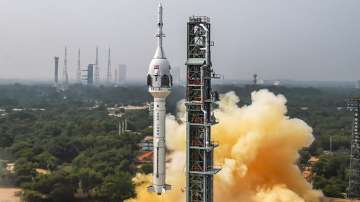Gaganyaan TV-D1 Mission: The Indian Space Research Organisation (ISRO) on Sunday released a video taken from the Gaganyaan TV-D1 test vehicle. The video offers a bird's eye view of the successful launch that took place on October 21.
The ISRO on Saturday launched the test vehicle which carried payloads related to India’s ambitious human space flight mission Gaganyaan. With the success of the Gaganyaan mission, India will be on the list of countries that can launch a crewed spacecraft by itself.
Watch the video here:
The video captured by the onboard camera showcased several key stages of the test, such as engine ignition, crew module separation, apex cover separation, and main chute deployment. It provides an insightful view of these critical moments during the test.
ISRO successfully launched Gaganyaan Mission
The ISRO scientists on Saturday launched the rocket carrying payloads related to crew safety in the Gaganyaan mission with precision from Sriharikota and achieved the goal of Crew Module and Crew Escape separation.
The launch was initially halted due to bad weather and then due to the failure of the engine of TV-D1 to ignite. The ISRO scientists put the mission on course 75 minutes later when the rocket lifted off and achieved the goal of Crew Module and Crew Escape separation.
TV D1 Mission was fully achieved, ISRO announced. The payloads splashed into the sea later which went as planned.
The test vehicle mission is aimed at studying the safety of the crew module and crew escape system in bringing astronauts back to Earth in the eventual mission.
This Flight test vehicle Abort mission is conducted to demonstrate the performance of the Crew escape system as part of the Gaganyaan mission. The mission objectives of the TV-D1 launch are- Flight demonstration and evaluation of Test Vehicle subsystems; flight demonstration and evaluation of the Crew Escape System including various separation systems; crew module characteristics; and deceleration system demonstration at higher altitudes and its recovery.
'Gaganyaan project envisages a demonstration of human spaceflight capability'
The Test Vehicle is a single-stage liquid rocket developed for this abort mission. The payloads consist of the Crew Module (CM) and Crew Escape Systems (CES) with their fast-acting solid motors, along with CM fairing (CMF) and Interface Adapters. This flight simulated the abort condition during the ascent trajectory corresponding to a Mach number of 1.2 encountered in the Gaganyaan mission. This mission represents a significant milestone in India's effort to demonstrate that it is possible to send humans into space.
The Gaganyaan project envisages a demonstration of human spaceflight capability by launching a crew of three members into an orbit of 400 km for a 3-day mission and bringing them safely back to earth by landing in Indian waters. This programme will make India the fourth nation to launch a manned spaceflight mission after the US, Russia, and China.
Building on the success of the Indian space initiatives, including the recent Chandrayan-3 and Aditya L1 missions, Prime Minister Narendra Modi directed that India should now aim for new and ambitious goals, including setting up 'Bharatiya Antariksha Station' (Indian Space Station) by 2035 and sending the first Indian to the Moon by 2040.
Also Read: Gaganyaan mission: 'Crew module is in safe hands of Indian Navy,' says ISRO
Also Read: PM Modi on Gaganyaan success: 'This launch takes us one step closer to...'
